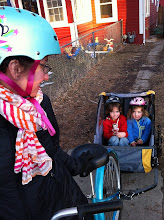Walking back today from the morning walk with Sydney, I looked over and saw something brightly colored in a small lot that is in front of a neighboring building. Formerly, the lot was full of rusting playground equipment and surprisingly minimal trash, some junkie graffiti. Today, there is a beautiful, brightly colored, brand spanking new children’s playground set up. A lemon yellow daisy towers over a sand box, there are swings, slides, those climby things kids love. The sunny beauty of it, juxtaposed with the gray day and all the depressing sights in this post-Soviet landscape just broke my heart with its implied hope for the future.
Living here, sometimes only when I leave do I realize how thick the mood is, how little hope people have sometimes, how much their spirits have been crushed, generation after generation.
That said, of course there are hopeful people and events here, but this overall spirit is part of what made last year’s Orange Revolution so special and dear in our hearts – what is more hopeful and forward thinking than revolution?
I stood and gazed in wonder at the playground, tears rolling down my cheeks, each one carrying the weight of what I see each day, what I hear. Thursday night’s taxi driver, a former sports champion during Soviet times, telling me, “There is no future for my children. We have no hope.” And me pressing a paltry extra 5 hryvna in his hand and saying, “I believe there is a future in Ukraine for your children. Goodbye, good luck.”
The last time we left the country, in September to go to Ireland, I walked through the Amsterdam airport, on the verge of tears (ok, anyone who knows me knows I’m rather easy to tear up, so please take these tales of woe with that caveat) just for being in a place where it feels like everything is ok.
Of course, everything is not ok in any one country, but the outward trappings of an airport where nice things are for sale and services run pretty smoothly is a start, a balm for the soul. Sometimes I feel like a wimp for feeling thus, but whatever, I’ve put in nearly three years working and living here so I must not be too wimpy.
There’s also something intrinsically different about the way people are here. It’s not just the famous Slavic not smiling, many European cultures aren’t smilers the way Americans are. There’s something I don’t pretend is quantifiable or in any way perhaps not in my head, about the spirit of Ukrainians.
I feel a weight, an old wound, a darkness that shrouds this place, at the same time as there is great beauty and ancient, ancient history. Perhaps the antiquity of this civilization is part of the darkness. Few old things stick around without hurts and aches and deep secrets. Maybe it’s hard on someone from a young and comparatively naïve culture to live in an old one that’s been beat around for a few centuries.
I do believe there is some truth to the idea that the history of oppression, misery and just plain geographical bad luck affects today’s Ukrainian. If every generation has had some major loss, back to time immemorial, certainly this must affect how people view the world, how and what they teach their children, how their governments are run, what food they eat.
I’m babbling. It’s time for a proper coffee and to begin this Saturday.
